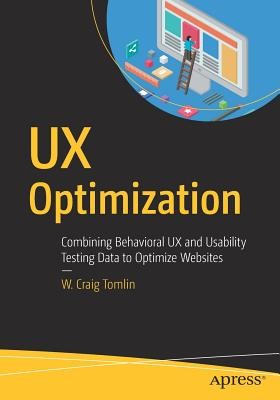
- We will send in 10–14 business days.
- Author: W Craig Tomlin
- Publisher: Apress
- ISBN-10: 1484238664
- ISBN-13: 9781484238660
- Format: 17.8 x 25.4 x 1.2 cm, softcover
- Language: English
- SAVE -10% with code: EXTRA
Reviews
Description
Combine two typically separate sources of data--behavioral quantitative data and usability testing qualitative data--into a powerful single tool that helps improve your organization's website by increasing conversion and ROI. The combination of the what is happening data of website activity, coupled with the why it's happening data of usability testing, provides a complete 360-degree view into what is causing poor performance, where your website can be optimized, and how it can be improved.
There are plenty of books focusing on big data and using data analytics to improve websites, or on utilizing usability testing and UX research methods for improvement. This is the first book that combines both subjects into a methodology you can use over and over again to improve any website.
UX Optimization is ideal for anyone who wants to combine the power of quantitative data with the insights provided by qualitative data to improve website results. The book uses step-by-step instructions with photos, drawings, and supporting screenshots to show you how to: define personas, conduct behavioral UX data analysis, perform UX and usability testing evaluations, and combine behavioral UX and usability data to create a powerful set of optimization recommendations that can dramatically improve any website.
What You'll Learn
- Understand personas: what they are and how to use them to analyze data
- Use quantitative research tools and techniques for analysis
- Know where to find UX behavioral data and when to use it
- Use qualitative research tools, techniques, and procedures
- Analyze qualitative data to find patterns of consistent task flow errors
- Combine qualitative and quantitative data for a 360-degree view
- Make recommendations for optimizations based on your findings
- Test optimization recommendations to ensure improvements are achieved
Who This Book Is For
Big data analytics (quantitative) professionals who want to learn more about the qualitative side of analysis; UX researchers, usability testers, and UX designers (qualitative professionals) who want to know more about big data and behavioral UX analysis; and students of UX, UX designers, product managers, developers, and those at startups who want to understand how to use behavioral UX and usability testing data to optimize their websites and apps.EXTRA 10 % discount with code: EXTRA
The promotion ends in 13d.23:18:10
The discount code is valid when purchasing from 10 €. Discounts do not stack.
- Author: W Craig Tomlin
- Publisher: Apress
- ISBN-10: 1484238664
- ISBN-13: 9781484238660
- Format: 17.8 x 25.4 x 1.2 cm, softcover
- Language: English English
Combine two typically separate sources of data--behavioral quantitative data and usability testing qualitative data--into a powerful single tool that helps improve your organization's website by increasing conversion and ROI. The combination of the what is happening data of website activity, coupled with the why it's happening data of usability testing, provides a complete 360-degree view into what is causing poor performance, where your website can be optimized, and how it can be improved.
There are plenty of books focusing on big data and using data analytics to improve websites, or on utilizing usability testing and UX research methods for improvement. This is the first book that combines both subjects into a methodology you can use over and over again to improve any website.
UX Optimization is ideal for anyone who wants to combine the power of quantitative data with the insights provided by qualitative data to improve website results. The book uses step-by-step instructions with photos, drawings, and supporting screenshots to show you how to: define personas, conduct behavioral UX data analysis, perform UX and usability testing evaluations, and combine behavioral UX and usability data to create a powerful set of optimization recommendations that can dramatically improve any website.
What You'll Learn
- Understand personas: what they are and how to use them to analyze data
- Use quantitative research tools and techniques for analysis
- Know where to find UX behavioral data and when to use it
- Use qualitative research tools, techniques, and procedures
- Analyze qualitative data to find patterns of consistent task flow errors
- Combine qualitative and quantitative data for a 360-degree view
- Make recommendations for optimizations based on your findings
- Test optimization recommendations to ensure improvements are achieved
Who This Book Is For
Big data analytics (quantitative) professionals who want to learn more about the qualitative side of analysis; UX researchers, usability testers, and UX designers (qualitative professionals) who want to know more about big data and behavioral UX analysis; and students of UX, UX designers, product managers, developers, and those at startups who want to understand how to use behavioral UX and usability testing data to optimize their websites and apps.

Reviews